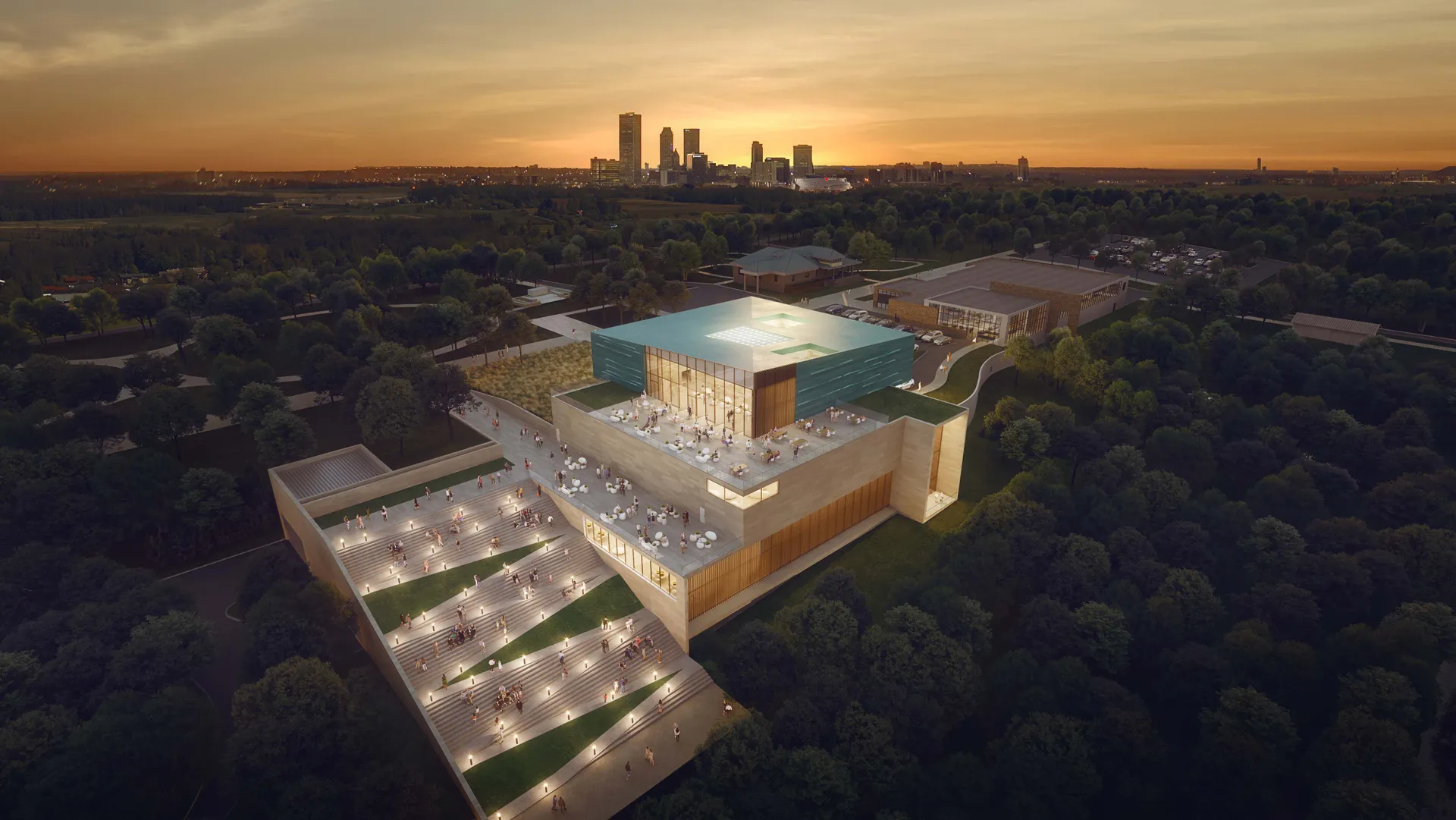TULSA IS IN THE MIDST OF A MASSIVE CULTURAL RENAISSANCE
With the opening of the Olson Kundig–designed Bob Dylan Center, the city has cemented itself as a must-see destination for lovers of art and culture
Outside of the all-new Bob Dylan Center, designed by the AD100 firm Olson Kundig. Photo: Courtesy of Olson Kundig
Just one year ago, in the spring of 2021, a broad swath of the national media turned their attention to Tulsa, Oklahoma, as the city commemorated the centennial of the 1921 Tulsa Race Massacre. That recognition of the city’s tragic past was a long time coming and merely the beginning of an ongoing path toward real and lasting reconciliation. Through initiatives like Black Tech Street and Build in Tulsa, the city is welcoming and fostering a new generation of Black entrepreneurs, hoping to recapture the spirit that birthed Black Wall Street over a century ago.
To quell the decades-long flight of creatives and young professionals to other urban centers, the Tulsa Remote project launched in 2018 and has brought well over 1,600 workers to northeast Oklahoma. Their timing was impeccable. If 2021 was a much needed look to a sobering past, 2022 is all about the future and hope. And the catalyst for much of that momentum is the May 10 opening of the Bob Dylan Center (BDC) in Tulsa’s downtown arts district.
Some may find confusing why 80-year-old Dylan chose a city some 860 miles south of his hometown of Duluth, Minnesota, as the location. “There’s more vibrations on the coasts, for sure,” Dylan explained in an interview with Vanity Fair. “But I’m from Minnesota, and I like the casual hum of the heartland.” What’s more, BDC will display items from Dylan’s archive, which was acquired in 2016 by the George Kaiser Family Foundation and the University of Tulsa for around $20 million. (The Kaiser foundation later bought out the university’s share.) If nothing else, the space, which was designed by AD100 firm Olson Kundig, will show how a Midwesterner with a guitar criss-crossed the world changing culture with his music. It will show how an outcast went on to win the Nobel Prize in literature. It will show how anything is possible in America.
Photo: Courtesy of Frida at Philbrook
Frida at Philbrook
Boasting an impressive trifecta of a historic home (72-room Italianate villa), art museum (from Italian Renaissance to Kehinde Wiley), and 25 acres of gardens (big wow factor), Philbrook Museum of Art has been a Tulsa favorite for well over 80 years. This summer’s special exhibition, “Frida Kahlo, Diego Rivera, and Mexican Modernism” (opening July 6, Frida’s birthday) is expected to bring record crowds. philbrook.org/Frida
Photo: The Gathering Place/Shane Bevel
The Gathering Place
Designed by the renowned landscape architect firm Michael Van Valkenburgh Associates, Gathering Place is the largest private gift (with a price tag of $465 million) to a community park in U.S. history. Named by USA Today as the country’s “best city park,” Gathering Place is a visually-stunning and 100-acre park which features an adventure playground, a lake and boat house, multi-story fireplaces, and over 80 species of trees.
Photo: Courtesy of the Oklahoma Museum of Popular Culture
The Oklahoma Museum of Popular Culture
An initiative of the Oklahoma Historical Society and the beneficiary of a $63 million budget that came from a variety of sources, OKPOP will document the history of Oklahoma music, film, theater, literature, and more. When it opens in 2023, the more than 60,000-square-foot facility will be located directly across the street from the legendary Cain’s Ballroom (former home to Bob Wills and his Texas Playboys, and one of the few spots the Sex Pistols ever played live). Tulsa-based Lilly Architects and Overland Partners of San Antonio, Texas, designed the much-anticipated museum.
Photo: Courtesy of Olson Kundig
The Bob Dylan Center
Already home to the Woody Guthrie Center, the Tulsa Arts District will become an international destination with the opening of the Bob Dylan Center (BDC) on May 10, 2022. The space will house the public face of The Bob Dylan Archive, and it will feature a massive and wide-ranging collection of materials from the legendary musician and Nobel laureate. More than a museum or a shrine to one man’s achievements, the BDC will use Dylan’s work to tell American stories while also revealing the inner-workings of the creative process. What's more, the new, Olson Kundig-designed structure will add to Tulsa's wealth of stunning architecture.
Photo: Courtesy of Greenwood Rising/Local Projects
Greenwood Rising
Opened in summer 2021, Greenwood Rising is an interactive museum and history center commemorating the 1921 Tulsa Race Massacre. This essential experience tells the stories not only of the Massacre itself and the people involved, but also of the remarkable and ever-resilient Greenwood community.
Due to generous community support, admission is currently free for all visitors.
Photo: Courtesy of the Church Studio/Phil Clarkin
The Church Studio
The late and great Leon Russell turned a church into a recording studio in 1972. After languishing for years, the historic structure has undergone a multi-million dollar renovation and restoration with top-notch equipment and design flourishes honoring its legendary and eccentric original owner, known colloquially as the Master of Space and Time.
The recording studio (which has hosted the likes of Tom Petty, J.J. Cale, Jimmy Buffett, Eric Clapton, Willie Nelson, and Stevie Wonder) recently reopened marking its 50th anniversary.
Photo: Courtesy of Gilcrease Museum/SmithGroup
Gilcrease Museum
Go west! But be patient. Home to the world’s largest collection of art and artifacts of the American West, Gilcrease Museum recently closed for a major multi-year renovation and reimagining.
With the original building raised and ground just broken, the new Gilcrease is officially underway with an anticipated reopening in 2024.








